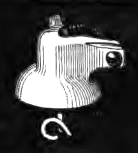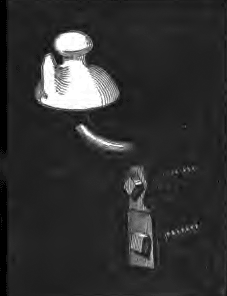[Book]
Publication: The History and Progress of the ELECTRIC TELEGRAPH
London, England
p. 215-227
VI. OVERHEAD LINES.
127. The overhead line-wire, stretched between two stations, is suspended by insulating hooks from posts in the ground.
The first line of this nature which was put to any useful purpose was the double line-wire of Gauss and Weber, erected principally for researches into the laws of the galvanic current, between the Physical Cabinet and the Observatory at Gottingen, a length of 3,000 yards, suspended between the towers of the city and on cross-pieces on poles sunk in the ground. The insulation of the wire from the poles was efl'ected by means of felt wrapped round the cross-pieces on which the wires were twisted. The insulation of this line was, of course, very imperfect. It was destroyed in 1844 by a stroke of lightning.
The English telegraph engineers were the first who succeeded in overcoming the chief difficulties which were found to obstruct the progress of overhead lines—difficulties which the continental telegraphists had partly avoided by the employment of an incomplete system of subterranean lines.
128. The posts generally pressed into the service of the telegraph abroad are young firs (Pinus sylvestris). They are selected from 25 to 30 feet long, and at the top seldom less than 5 inches diameter. The bark is stripped off, and the posts smoothed, chamfered off, and either impregnated or the lower ends charred up to about 8 feet from the bottom. Every tenth post is, or should be, a stretching-post, stronger than the others.
The wooden posts mostly in use here are of English larch; but foreign timber, although dearer, is preferable on account of its greater durability.
Impregnation with a solution of sulphate of copper is the invention of a Frenchman, Dr. Boucherie. His process seems to possess important advantages over others, accomplishing as it does, at the same time, two essential objects - that of expelling the sap, and that of filling the pores of the wood with the preservative solution.
In his experiments on the impregnation of timber, Dr. Boucherie has made the important discovery that no connection exists laterally between the tubes of a tree, and that by applying, under moderate pressure, a coloured solution to certain tubes at one end of a tree, the same tubes at the other end, and only these, are coloured. In this way, at one end of a felled tree, he applied a coloured solution to certain tubes forming the name "Faraday." The name was transmitted to the other end, and was perfect at every intermediate section.
When the tree is cut down and trimmed, a solution of sulphate of copper is forced into it from one end to the other by a moderate pressure. The sap and fermenting matter are thus expelled, and their place taken up by the solution. The small cost of the apparatus, ease of manipulating it, and the increased durability which it imparts to the wood treated by it, highly recommend the process. It is necessary, however, to take care that no ungalvanised iron comes in contact with wood so impregnated, otherwise the copper of the preservative solution will be reduced.
Chloride of zinc is also used in Germany with some success. The posts are put into wrought-iron cylinders of 4-1/2 to 6 feet diameter, and 34 to 60 feet long, closed at one end, and covered at the other with tightly-fitting tops. The cylinders are provided with manometers, safety-valves, &c., and connected with air and pressure pumps, and a reservoir of zinc solution. The wood is prepared by being subjected to a great pressure of steam, which, penetrating into the interior, not only tends to displace the sap from the pores and prepare them for the preservative solution, but also to coagulate the albumen which is in the sap, and in this way to retard the subsequent rotting. After this the cylinders are exhausted, and immediately filled with a solution of one part of chloride of zinc and thirty parts of water, which is kept on, under a pressure of eight to ten atmospheres, for about three hours.
But it is questionable if this method is so good as that of Boucherie, as it is necessary to force the solution into the wood at right angles to its tubes, thereby injuring its strength, and letting the sap, which is the immediate cause of decay, remain; the coagulation of the albumen in the sap, to any material depth below the surface, being a matter of doubt.
Chloride of manganese, as well as a solution of oxide of zinc in wood vinegar, have been tried, and not without success. The former has the advantage of cheapness, being produced in great quantities in the manufacture of chloride of lime, and, being an incidental product, has a very small commercial value.
The method adopted by Sir Charles Bright is to have the poles well charred from the lower ends to a foot above the depth to which they are destined to be fixed into the ground, and the charred parts soaked in gas-tar for about twelve hours, the poles standing in tanks of tar in a timber framing.
The sap ingredients being the prime movers in the rotting of dead wood, the idea has occurred to put up insulators on the stems of living trees—a method which has been found to answer well in Switzerland, America, and in some parts of Germany, where trees are to be found at convenient distances. The only drawback to this system is the violence with which trees are sometimes moved in heavy storms. To obviate this difficulty, Lieut.-Col. Chauvin has constructed a swinging insulator, which will be described afterwards.
Wooden posts invariably decay first at the ground level—"the wind and water line"—where the surface is moist and in contact with the air. A method of retarding the decay by sheathing the post at this part has been tried in India with comparative success, the lower end, to a certain height above the ground, being covered by an iron casing. In Bengal such a line was erected, the posts being of large bamboo canes, and the protection of the lower parts cast-iron sockets.
129. This brings us very near to a suggestion which has been much advocated — that of dispensing with wood, and constructing the posts entirely of iron, whose durability is so superior. The greater cost of such posts is the only objection to them.
Pillars of stone, or masons' work, would undoubtedly not only last longer, but would be less liable to accidents by violence of the weather. Such supports have repeatedly been constructed, but their cost has always been a bar to their further employment. In India, in the early days of telegraphy, many such pillars were erected; and in 1852 a line from Treviso to Tagliamento was entirely supported by obelisks 4-1/2 metres high, as shown in Fig. 101. In Switzerland they have begun in good earnest the use of iron posts, the line from Olten to Sissach, lately erected, being supported entirely by iron posts. In Prussia also the necessity has been fully comprehended of discarding wood and taking to some more durable material. M. Borggreve has employed, on the line between Gera and Weissenfels, a pillar constructed of a wrought-iron tube, 1-1/2 inch diameter, fixed with lead into a socket on the top of a freestone pillar, 6 feet high and 8 inches square.
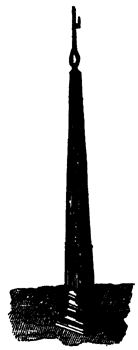 |
| Fig. 101. |
130. The iron post of M. W. Siemens is coming very generally into use abroad, and will no doubt find employment in England also, when the necessity of a durable post becomes thoroughly appreciated.
This post is formed of two tubes, one set upon the other, and the bottom of the lower one made fast to a bent plate of iron buried in the ground. One of them is shown in Fig. 102. The base consists of one of Mr. Kobert Mallet's patent buckled wrought-iron plates, 1 foot 9 inches square, bent in a dish form. The buckled plate, a a, is secured by four bolts to the socket, b b — a cast-iron cylindrical tube 7 feet long and 4 inches outside diameter. Near the top, inside, the socket is furnished with a flange, upon which the bottom of the upper or main post, as it is called, rests. This upper post, c c, is of wrought-iron with welded joints; it stands 12 feet high out of the socket, and is somewhat conical. At its upper end an iron ring is welded in to carry an iron rod, ~d~, 20 inches long, forming the lightning-guard. The stretching-posts are of the same height, but of larger diameter and stronger than the ordinary ones.
M. Siemens' post derives much of its merit from the role played by the buckled plate at the bottom. These buckled plates are things of great engineering utility. They are squares of sheet-iron, which Mr. Mallet by a simple process presses into a form very slightly different, but endows them with a strength immensely superior; so strong indeed are they, that if one of these posts were pulled up bodily out of the ground, it would bring up the superincumbent ground with it, and the buckled plate would not be deranged unless the bolts gave way; while the same piece of iron, as a simple sheet, would bend under Fig. 102. a much less weight, offering no resistance worth speaking of against the strain.
 |
| Fig. 102. |
131. The French Telegraph Administration has had some iron posts put up by way of experiment. This post is constructed by Messrs. Menans and Co., of Paris. It consists of a cast-iron socket standing 8 metres out of the ground, in the upper part of which is wedged and cemented the end of a length of 2.5 metres of rolled + section iron, tapering from 0.07 to 0.05 metre in width, and is 0.01 metre thick in the ribs. These posts, notwithstanding their very slight appearance, are found to be capable of resisting a considerable strain. The same weight of material could, however, be more profitably employed in the form of a tube.
There can be little doubt that, in course of time, only metal posts will be employed, on account of their superior durability, solidity, and freedom from damage by accidents. In some climates wooden posts require to be renewed every two or three years, and, in the most favourable, rarely last over six years; while an iron telegraph post is as durable as a lamp-post, and would certainly last ten times as long, and not cost five times as much, as a wooden one; so that in the end an immense saving would be effected by their employment, although the first cost is so much greater.
132. Line Insulators.—There are two different ways of supporting overhead telegraph lines. The one, as in use in Prussia, and generally in England, consists in securing the line-wire rigidly to the insulators on each of the posts, so that each insulator has the same vertical and horizontal strains to withstand. The other method—that adopted in France and Belgium—consists in attaching the wire rigidly to the insulators of two distant posts, and supporting it only by hooks at a number of intermediate points ; so that the horizontal strains are borne only by what are called the stretching-posts, whilst the intermediate posts, in common with the stretchers, have to support the weight or vertical strain. Of the two methods we give the preference to the former; because, should a wire break, it can then only affect one span; whereas, with the other method, it runs back into the other spans, which increases the chances of short circuits being made with the other lines, and of the insulators being broken.
The insulators at present employed in supporting overhead telegraph lines are of three kinds:—1, those formed of a single piece of insulating material; 2, those formed of two or more insulating cups cemented together; and, 3, those supplied with an outer armature of iron. To the first kind belong the so-called double-cup insulators of Mr. Latimer Clark, of which large numbers are in use in England, and almost exclusively in Prussia, where they are generally known as Chauvin's insulators.
133. In 1856 Mr. Clark patented an insulator in which he increased the length of surface of the porcelain over which the current escapes, without increasing its section. He attained this by a double bell formed in one piece. The insulator is supported by a stalk, D, Fig. 103, cemented into the interior of the inner cavity; the line-wire is carried through a deep groove on the top, and is tied to the bell by a binding wire.
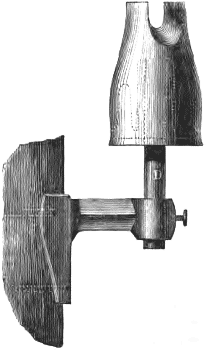 |
| Fig. 103. |
Lieut.-Col. Chauvin, Director of Prussian Telegraphs, has adopted this style of insulation for the lines under his charge. He has also made numerous experiments on the most favourable proportions between the length and section of the cups, and has given them a form differing from Mr. Clark's only in an increased depth and narrowness of the inner cavity, bywhich the deposit of dampness from the atmosphere is still further guarded against, as well as the sudden cooling of the insulator bell.
134. The Spanish insulator is of this class; it consists of a porcelain bell, b, Fig. 104, supported by a strap of hoop-iron fitting into the groove g, and screwed to the post. The line-wire is carried by a stalk cemented into the inner recess of the bell. The chief merit of this insulator is its cheapness. In climates like that of Spain it answers well enough, but would be utterly useless in England, where the atmosphere is always charged heavily with water vapour, which, condensing on the surface, would soon occasion a material loss of current.
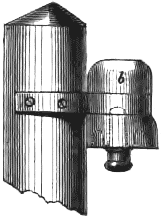 |
| Fig. 104. |
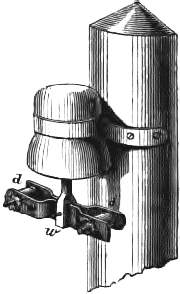 |
| Fig. 105. |
The Spanish stretching insulator is formed with a similar bell, by means of a wrought-iron winch, w, attached to the stalk, as in Fig. 105. The ends of the line-wire on each side are passed through holes in the two drums, d d', and wound up tightly, the drums being prevented from running back by ratchet-wheels on their axles being kept by clicks.
135. The insulator used upon the Belgian lines resembles the Spanish insulator; only the iron band which supportsit is placed higher up, and the cup underneath is deeper and better adapted for remaining clean and well-insulating.
136. The French Administration has adopted, for general use upon its lines, perhaps the worst insulators which are to be found on the Continent. This insulator, shown in Fig. 106, is provided with two ears or flanges, each of which has a hole for the screws to be passed through, which are used in fastening them to the posts. In the interior cavity is cemented a hook of galvanized iron. The under part of this insulator presents the appearance of a cup inverted; but, until now, an insufficient surface has been given to it to insure its insulating in damp weather.
| |||
| Fig. 106. |
The stretching insulator used on the French lines is shown in Fig. 107. It consists of a mushroom-shaped head and inverted cup of white porcelain, cemented upon a curved bracket, which is attached to the post by means of two coach screws. The line-wire from each side is turned twice round the neck at the top, and then twisted back round itself.
| |||
| Fig. 107. |
137. The second class of line-supports—those formed with two separate cups—is represented by the excellent insulator of Mr. Cromwell Varley. This insulator is that most commonly employed in England. It consists of two separate red earthenware cups, a and b (Fig. 108), cemented together with sulphur. The outer cup, a, is provided with a groove to which the line-wire is bound; in the recess of the inner cup, b, a wrought-iron bolt, c, is cemented, by which the insulator is attached to a bracket, d, on the post. A further insulation is obtained by coating the stalk with vulcanite. The rim of the outer cup, a, is rounded off inside. The purpose of this is to avoid the sprinkling of the interior with rain-water, when a drop, hanging upon the bottom rim, is blown off by the wind. When a strong current of air separates a drop of water from a sharp corner, the drop is never carried bodily off, but bursts in the direction of the current. With the form given to the rim by Mr. Varley, however, when a drop happens to hang on that side from which the wind comes, it is driven a little way up between the two cups, and does not burst.
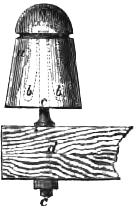 |
| Fig. 108. |
138. The line-insulator of the War Department of Austria belongs, also, to this class. It consists of two bells, one glass and the other vulcanised india-rubber. The india-rubber bell has a cavity into which a pin on the top of the telegraph-post is forced. The glass bell is then drawn on, and is held firmly in its place by the elasticity of the india-rubber.
139. The third kind of line-insulator is the strongest and most expensive of all. The first insulator of this kind was that made by Messrs. Siemens, of Berlin. It consists of a cast-iron bell, a a (Fig. 109), with a flange, b b, by which it is screwed against the post. Inside the bell is cemented a porcelain cup, c c, ribbed inside and out to give a good hold to the Fig 109 cement. The cup, c c, in turn, carries the stalk or hook, d d, which supports the line-wire. The parts are put together, while hot, with a cement composed of sulphur and oxide of iron. As a further mode of insulation, the iron stalks or hooks are covered with vulcanite before being cemented in; sometimes the porcelain cup is replaced by a cup of vulcanite. These insulators are a little heavy, but their superior solidity and insulation are ample compensation, the iron cap forming at once a perfect protection against injury and a screen against the deposit of dew on the porcelain.
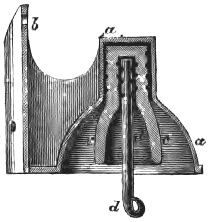 |
| Fig. 109. |
Siemens and Halske's stretching insulator is made with a stronger and larger cast-iron bell than the ordinary one. The porcelain boss or cup carries a stalk with two notches (Fig. 110), through which the wire is drawn and wedged on each side, leaving a loop between them. In cold weather, when the line contracts, this loop allows the wire between the posts to be slackened, and also, in case of a rupture, gives sufficient space for making a joint.
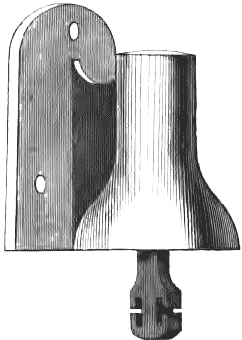 |
| Fig. 110 |
140. Lieut.-Col. Chauvin has also constructed an insulator belonging to this class, for attaching to the stems of living trees when these are used instead of posts for the support of telegraph lines. The insulator is hung upon a hook, free to swing about, and the stalk, or wire-carrier, bent in a curve away from the stem of the tree, that, when the latter is deflected by the wind, the line-wire, in swinging, may not come into contact with it. The hook, Q (Fig. 111), held in the loop, f, of the bracket, M M', is twisted so that, in case of a sudden jerk, the line cannot be thrown upwards and the insulator disengaged from the bracket. The carrier, o, is also bent over the wire, to prevent the line jumping out. The bracket is formed so that the insulator hangs quite free of the stem.
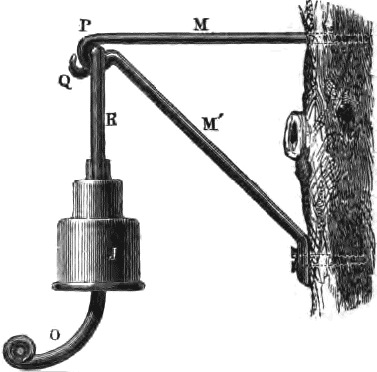 |
| Fig. 111. |
141. An insulator of this class, invented by Mr. David Brooks, of Philadelphia, has of late years been introduced in great numbers on the American lines. It consists of an outer cylindrical cast-iron armature, a a (Fig. 112), in which is cemented an inverted green-glass bottle, b b, of such a form as to allow a stalk or carrier, c c, of malleable cast-iron, to be cemented into its interior: The cement used in making up this insulator is sulphur, the surfaces being previously washed with shellac. The space, d d, therefore, offers of itself a considerable insulative resistance, which is still further increased by the use of paraffine. Mr. Brooks has found that the inner surface of a green-glass bottle which has not touched the form in blowing resists a deposit of water and dirt more than most other insulating materials. The experiments made on these insulators by the Commission de Perfection of the French Telegraph Administration have established their claim to be amongst the best insulators which we possess.
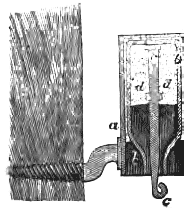 |
| Fig. 112. |

